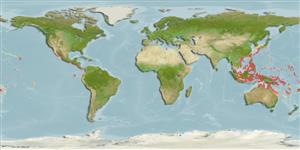>
Gobiiformes (Gobies) >
Gobiidae (Gobies) > Gobiinae
Etymology: Eviota: No etymology given, suggested by Christopher Scharpt: from Latin 'eu' for 'true' and 'iota' for anything very small, in combination 'truly very small' referring to it as being the smallest vertebrate at the time it has benn described by Jenkins (thus, making the suggestion by Scharpt plausible..
Environment: milieu / climate zone / depth range / distribution range
Ecología
marino asociado a arrecife. Tropical
Distribución
Países | Áreas FAO | Ecosistemas | Ocurrencias, apariciones | Point map | Introducciones | Faunafri
Indo-Pacific: Japan, Micronesia (Palau and Yap), Hong Kong, northern Vietnam, Philippines, Indonesia (Java and Kalimantan to West Papua), and Western Australia.
Tamaño / Peso / Age
Maturity: Lm ? range ? - ? cm
Max length : 2.5 cm SL macho / no sexado; (Ref. 48637)
Short description
Claves de identificación | Morfología | Morfometría
Espinas dorsales (total) : 7 - 8; Radios blandos dorsales (total) : 8 - 9; Espinas anales: 1; Radios blandos anales: 7. Characterized by semi-translucent greyish body with internal stripe of alternating white and reddish brown; large brownish patch on lower side just posterior to pectoral fin base punctuated with large irregular white spots; from nape, along dorsal fin base, to dorsal surface of caudal peduncle with 14 brown spots/saddles; above anal fin base with 6-7 similar brown and white marks; first four dorsal spines of male and first two spines of female often elongate and filamentous; all pectoral rays unbranched; longitudinal scale series 22-23; ctenoid scales except on head, nape, breast and pectoral fin base; separated pelvic fins, bases joined by thin membrane; fourth pelvic ray with 2-8 branches; depth of body 4.0-4.5 in SL (Ref. 90102).
Inhabits shallow inshore algal reefs (Ref. 48637).
Life cycle and mating behavior
Maturities | Reproducción | Spawnings | Egg(s) | Fecundities | Larva
Lachner, E.A. and S.J. Karnella, 1980. Fishes of the Indo-Pacific genus Eviota with descriptions of eight new species (Teleostei:Gobiidae). Smithson. Contrib. Zool. (315):127 p. (Ref. 5293)
IUCN Red List Status (Ref. 130435)
Threat to humans
Harmless
Human uses
Herramientas
Special reports
Download XML
Fuentes de Internet
Estimates based on models
Preferred temperature (Ref.
123201): 24.9 - 29.3, mean 28.6 °C (based on 1961 cells).
Phylogenetic diversity index (Ref.
82804): PD
50 = 0.5000 [Uniqueness, from 0.5 = low to 2.0 = high].
Bayesian length-weight: a=0.00708 (0.00333 - 0.01504), b=3.09 (2.92 - 3.26), in cm total length, based on LWR estimates for this (Sub)family-body shape (Ref.
93245).
Nivel trófico (Ref.
69278): 3.1 ±0.3 se; based on size and trophs of closest relatives
Resiliencia (Ref.
120179): Alto, población duplicada en un tiempo mínimo inferior a 15 meses (Preliminary K or Fecundity.).
Fishing Vulnerability (Ref.
59153): Low vulnerability (10 of 100).
Nutrients (Ref.
124155): Calcium = 409 [171, 1,195] mg/100g; Iron = 1.55 [0.66, 3.47] mg/100g; Protein = 17.6 [15.5, 19.5] %; Omega3 = 0.104 [0.035, 0.292] g/100g; Selenium = 31.8 [9.4, 94.2] μg/100g; VitaminA = 123 [24, 599] μg/100g; Zinc = 4.33 [2.38, 7.27] mg/100g (wet weight);
